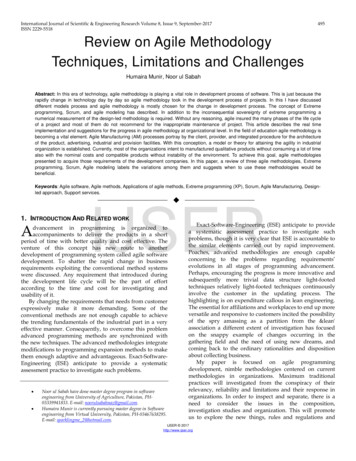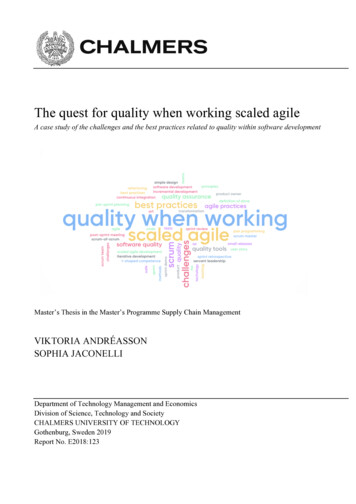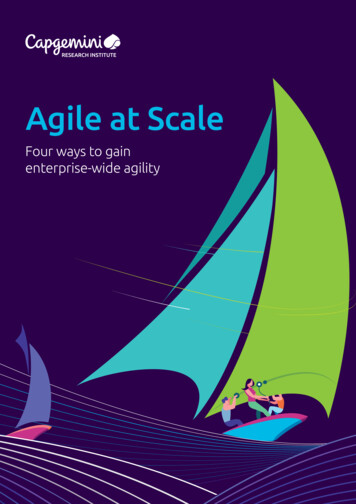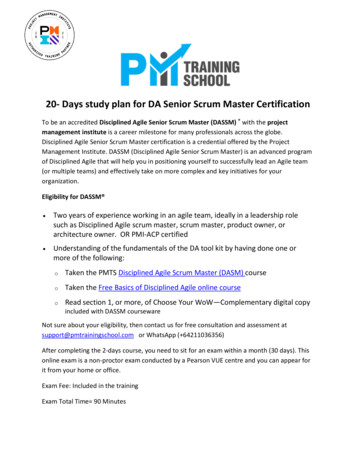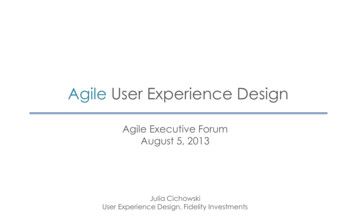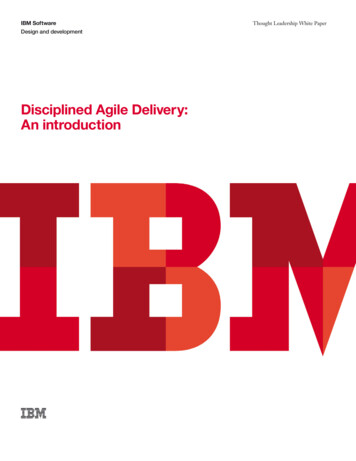
Transcription
IBM SoftwareDesign and developmentDisciplined Agile Delivery:An introductionThought Leadership White Paper
2Disciplined Agile Delivery: An introductionMake no mistake, agile is not a fad. When mainstream agilemethods such as Scrum and Extreme Programming (XP) wereintroduced, the ideas contained in them were not new, nor werethey even revolutionary at the time. In fact, many of them havebeen described in-depth in other methods such as RapidApplication Development (RAD), Evo, and various instantiationsof the Unified Process, not to mention classic books such asFrederick Brooks’ The Mythical Man Month. It should not be surprising that working together closely in co-located teams andcollaborating in a unified manner towards a goal of producingworking software produces results superior to those based onworking in specialized silos concerned with individual ratherthan team performance. It should also come as no surprise thatreducing documentation and administrative bureaucracy savesmoney and speeds up delivery.Agile was once considered viable only for small, co-locatedteams; more recently, improvements in product quality, teamefficiency, and on-time delivery—all attributable to agilepractices—have caused larger teams to take a closer look atadopting agile principles in their environments. A recent studyconducted by the Agile Journal determined that 88 percentof companies, many with over 10,000 employees, are using orevaluating agile practices on their projects. Agile is truly poisedto become the dominant software development paradigm. Thistrend is also echoed in other industry studies, including one conducted by Dr. Dobb’s Journal which found a 76 percent adoptionrate of agile techniques, and within those organizations doingagile, 44 percent of the project teams on average are applyingagile techniques in some way.Unfortunately, we need to take adoption rate survey results witha grain of salt: A subsequent Ambysoft survey found that only53 percent of people claiming to be on “agile teams” actuallywere. It is clear that agile methods have been overly hyped byvarious media over the years, leading to abuse and misuse; infact, the received message regarding agile appears to have justified using little or no process at all. For too many project teamsthis resulted in anarchy and chaos, leading to project failures anda backlash from the IT community that prefers more traditionalapproaches.Properly executed, agile is not an excuse to be undisciplined. It isclear that the execution of mainstream agile methods such as XPhave always demanded a disciplined approach, certainly morethan traditional approaches such as waterfall methods—don’tmistake the high ceremony of many traditional methods to be asign of discipline, rather it’s a sign of rampant and often out-ofcontrol bureaucracy. However, mainstream agile methods don’tprovide enough guidance for the typical enterprise. Matureimplementations of agile recognize a basic need in enterprisesfor a level of rigor that core agile methods dismiss as notrequired, such as governance, architectural planning, and modeling. Most mainstream agile methods admit that their strategiesrequire significant additions and adjustments to scale beyondteams of about eight people who are working together in closeproximity. Furthermore, most Fortune 1000 enterprises andgovernment agencies have larger solution delivery teams that areoften geographically distributed, so the required tailoring effortscan prove both expensive and risky. It is time for a new generation of agile process framework.
IBM Software3Here are the big ideas in this paper:People are the primary determinant of success forIT delivery projects.Moving to a Disciplined Agile Delivery process is the first stepin scaling agile strategies.Disciplined Agile Delivery (DAD) is an enterprise-awarehybrid software process framework.Agile strategies should be applied throughout the entiredelivery life cycle.Agile teams are easier to govern than traditional teams.The ASM, depicted in Figure 1, defines three process categories:Context counts—The agile scaling model2. Disciplined Agile Delivery:1 These methods—including theDAD process framework (described in this paper) andHarmony/ESW—address the full delivery life cycle fromproject initiation to production. Where appropriate, they addlean governance techniques to balance self organization andadd a risk-driven viewpoint to the value-driven approach toincrease the chance of project success. Like core agile methods, these methods focus on small co-located teams developing straightforward solutions. To understand the need for the Disciplined Agile Delivery(DAD) process framework you must start by recognizing therealities of the situation you face. The Agile Scaling Model(ASM) is a contextual framework that defines a roadmap toeffectively adopt and tailor agile strategies to meet the uniquechallenges faced by an agile software development team. Thefirst step to scaling agile strategies is to adopt a Disciplined AgileDelivery life cycle that scales mainstream agile constructionstrategies to address the full delivery process from project initiation to deployment into production. The second step is to recognize which scaling factors, if any, are applicable to a projectteam and then tailor your adopted strategies to address the rangeof complexities the team faces.1. Core agile development: Core agile methods—suchas Scrum, XP, and Agile Modeling (AM)—focus onconstruction-oriented activities. They are characterized byvalue-driven life cycles where high-quality, potentially shippable software is produced on a regular basis by a highlycollaborative, self-organizing team. The focus is on small( 15 member) teams which are co-located and are developingstraightforward software.3. Agility@Scale: This is Disciplined Agile Delivery, where oneor more scaling factors apply. The scaling factors that anagile team may face include team size, physical distribution,organizational distribution, regulatory compliance, cultural ororganizational complexity, technical complexity, and enterprisedisciplines (such as enterprise architecture, strategic reuse, andportfolio management).
4Disciplined Agile Delivery: An introductionAgility@Scale* Disciplined agile delivery when one or more scaling factors apply:- Large team size- Geographic distribution- Regulatory compliance- Domain complexity- Organization distribution- Technical complexity- Organizational complexity- Enterprise disciplineDisciplinedAgile Delivery* Risk value-driven life cycle* Self-organizing within appropriate governance framework* Full delivery life cycleCore AgileDevelopment* Value-driven life cycle* Self-organizing teams* Focus on constructionFigure 1: The Agile Scaling Model (ASM)This paper describes the DAD process framework. In most caseswe assume that your team is small ( 15 people), either colocated or near-located (in the same building), and workingon a relatively straightforward solution.What is the Disciplined Agile Delivery(DAD) process framework?Let’s begin with a definition:“The Disciplined Agile Delivery (DAD) process frameworkis a people-first, learning-oriented hybrid agile approach toIT solution delivery. It has a risk-value life cycle, is goal-driven,and is enterprise aware.”
IBM SoftwareFrom this definition, you can see that the DAD processframework has several important characteristics. Thesecharacteristics are: People firstLearning-orientedAgileHybridIT solution focusedGoal-driven delivery life cycleRisk and value drivenEnterprise aware.To gain a better understanding of DAD, let’s explore each ofthese characteristics in greater detail.People firstAlistair Cockburn refers to people as “nonlinear, first-ordercomponents” in the software development process. His observation, based on years of ethnographic work, is that people and theway that they collaborate are the primary determinants of success on IT efforts. This philosophy, reflected in the first valuestatement of the Agile Manifesto, permeates DAD. DAD teammembers should be self-disciplined and DAD teams should beself organizing and self aware. The DAD process frameworkprovides guidance which DAD teams leverage to improve theireffectiveness, but it does not prescribe mandatory procedures.5The traditional approach of having formal handoffs of workproducts (primarily documents) between different disciplines—such as requirements, analysis, design, test, and development—creates bottlenecks and is a huge waste of time and money.Handoffs between people often create misunderstandings andinjection of defects and are described in lean software development as one of the seven sources of waste. When we create adocument we will not document our complete understanding ofwhat we are describing and inevitably some knowledge is “leftbehind” as tacit knowledge that is not passed on. It is easy to seehow, after many handoffs, the eventual deliverable may bear littleresemblance to the original intent. In an agile environment,the boundaries between disciplines should be torn down andhandoffs minimized in the interest of working as a team ratherthan a group of specialized individuals.In DAD we foster the strategy of cross-functional teams madeup of cross-functional people. There should be no hierarchywithin the team, and team members are encouraged to be crossfunctional in their skill set and indeed perform work related todisciplines other than their specialty. The increased understanding gained beyond a team member’s primary discipline results inmore effective use of resources and the reduced reliance on formal documentation and sign-offs.
6Disciplined Agile Delivery: An introductionAs such, agile methods deemphasize roles based strictly onskillsets in favor of primary roles that can include a varietyof skills. Accordingly, the five primary roles of DAD are:1. Stakeholder: A stakeholder is someone who is materiallyimpacted by the outcome of the solution. The stakeholder isclearly more than an end user: A stakeholder could be a directuser, indirect user, manager of users, senior manager, operations staff member, the “gold owner” who funds the project,support (help desk) staff member, auditor, your program/portfolio manager, developers working on other systems thatintegrate or interact with the one under development, ormaintenance professionals potentially affected by thedevelopment and/or deployment of a software project.2. Product owner: The product owner is the individual on theteam who speaks as the “one voice of the customer.” Theyrepresent the needs and desires of the stakeholder communityto the agile delivery team. As such, he or she clarifies anydetails regarding the solution and is also responsible formaintaining a prioritized list of work items that the team willimplement to deliver the solution. While the product ownermay not be able to answer all questions, it is their responsibility to track down the answer in a timely manner so that theteam can stay focused on their tasks. Having a product ownerworking closely with the team to answer any question aboutwork items as they are being implemented substantiallyreduces the need for documentation. Each DAD team, orsub-team in the case of large programs organized into a teamof teams, has a single product owner. A secondary goal for aproduct owner is to represent the work of the agile team tothe stakeholder community. This includes arranging demonstrations of the solution as it evolves and communicatingproject status to key stakeholders.3. Team member: The team member focuses on producing theactual solution for stakeholders. Team members will performtesting, analysis, architecture, design, programming, planning,estimation, and many more activities as appropriate throughout the project. Note that not every team member will haveevery single one of these skills, at least not yet, but they willhave a subset of them and they will strive to gain more skillsover time. Team members are sometimes described by coreagile methods as “developers” or simply as programmers.However, in DAD we recognize that not every team membernecessarily writes code.4. Team lead: The team lead is the agile coach, helping to keepthe team focused on delivering work items and fulfilling theiriteration goals and commitments that they have made to theproduct owner. He or she acts as a true leader, facilitatingcommunication, empowering them to self-optimize theirprocesses, ensuring that the team has the resources that itneeds, and removing any impediments to the team (issueresolution) in a timely manner.5. Architecture owner: The architecture owner makes thearchitecture decisions for the team and facilitates the creationand evolution of the overall solution design. Architecture is akey source of project risk and someone needs to be responsible for ensuring the team mitigates this risk. Note that thearchitecture owner doesn’t dictate the architecture of the solution, but instead leads its formulation. On small projects theteam lead is often the architecture owner.Notice that tester and business analyst are not primary roles inthe DAD process framework. Rather, a generic team membershould be capable of doing multiple things. A team member whospecializes in testing might be expected to volunteer to help withrequirements, or even taking a turn at being the Scrum Master
IBM Software(team lead). This doesn’t imply that everyone needs to be anexpert at everything, but it does imply that as a whole the teamshould cover the skills required of them, and should be willing topick up any missing skills as needed.Team members should be “generalizing specialists”—a specialistin one or more disciplines but with general knowledge of otherdisciplines as well. More important, generalizing specialists arewilling to collaborate closely with others, to share their skills andexperiences with others and to pick new skills up from the people they work with. A team made up of generalizing specialistsrequires few handoffs between people, enjoys improved collaboration because the individuals have a greater appreciation of thebackground skills and priorities of the various IT disciplines, andcan focus on what needs to be done as opposed to focusing onwhatever their specialties are.DAD teams and team members should be:Self-disciplined, in that they commit only to the work whichthey can accomplish and then perform that work as effectivelyas possible.Self-organizing, in that they will estimate and plan their ownwork and then proceed to collaborate iteratively to do so.Self-aware, in that they strive to identify what works well forthem, what doesn’t, and then learn and adjust accordingly. Although people are the primary determinant of success forIT projects, in most situations it isn’t effective to simply puttogether a good team of people and let them loose on the problem at hand. If you do this the teams run several risks, includinginvesting significant time in developing their own processes andpractices, in identifying the wrong processes and practices, in notidentifying the right processes and practices, and in tailoringthose processes and practices ineffectively. In other words, people are not the only determinant of success. The DAD processframework provides coherent, proven advice that agile teamscan leverage and thereby avoid or at least minimize the risksdescribed above.7Learning-orientedIn the years since the Agile Manifesto, we’ve discovered that themost effective organizations are the ones that promote a learningenvironment for their staff. There are three key aspects whicha learning environment must address. The first is domainlearning—how are you exploring and identifying what yourstakeholders need, and perhaps more importantly how are youhelping them to do so? The second is learning to improve yourprocess at the individual, team, and enterprise levels. The third istechnical learning, which focuses on understanding how to effectively work with the tools and technologies being used to craftthe solution for your stakeholders.The DAD process framework suggests several strategies to support domain learning, including initial requirements envisioning,incremental delivery of a potentially consumable solution, andactive stakeholder participation through the life cycle. To support process-focused learning, DAD promotes the adoptionof retrospectives where the team explicitly identifies potentialprocess improvements, a common agile strategy, as well as continued tracking of those improvements. Within IBM SoftwareGroup we’ve found that agile teams that held retrospectivesimproved their productivity more than teams that did not,and teams that tracked their implementation of the identifiedimprovement strategies were even more successful. Technicallearning often comes naturally to IT professionals, many ofwhom are eager to work with and explore new tools, techniques,and technologies. This can be a double-edged sword—althoughthey’re learning new technical concepts they may not investsufficient time to master a strategy before moving on to the nextone, or may abandon a perfectly fine technology simply becausethey want to do something new.There are many general strategies for improving your learningcapability. Improved collaboration between people correspondingly increases the opportunities for people to learn from one
8Disciplined Agile Delivery: An introductionanother, and high collaboration is a hallmark of agility. Investingin training, coaching, and mentoring are productive learningstrategies as well. Less intuitive, though, is the value in movingaway from specialization within your staff and instead fosteringmore robust skills—valuing, that is, the generalizing specialist.Progressive organizations aggressively promote learning opportunities for their people outside their specific areas of specialtyas well as opportunities to actually apply these new skills.If you’re experienced with, or at least have read about, agilesoftware development, then the previous strategies should soundvery familiar. Where the DAD process framework takes learningfurther is through enterprise awareness. Core agile methods suchas Scrum and XP are typically project focused, whereas DADexplicitly strives to both leverage and enhance the organizationalecosystem in which a team operates. So DAD teams shouldleverage existing lessons learned from other agile teams andalso take the time to share their own experiences. The implication is that your IT department needs to invest in a technologyfor socializing the learning experience across teams. In 2005,IBM Software Group implemented internal discussion forums,wikis, and a center of competency (some organizations call themcenters of excellence) to support their agile learning efforts.A few years later they adopted a Web 2.0 strategy based onIBM Lotus Connections to support enterprise learning.(no defined process) approach. High quality is achieved throughtechniques such as continuous integration (CI), developerregression testing, test-first development, and refactoring.Improved ROI comes from a greater focus on high-valueactivities, through working in priority order, through automationof as much of the IT drudgery as possible, through self organization, through close collaboration, and in general from workingsmarter, not harder. Greater stakeholder satisfaction is achievedby enabling active stakeholder participation, by incrementallydelivering a potentially consumable solution with each iteration,and by enabling stakeholders to evolve their requirementsthroughout the project.A hybrid process frameworkDAD is the formulation of many strategies and practices fromboth mainstream agile methods as well as other sources. TheDAD process framework extends the Scrum construction lifecycle to address the full delivery life cycle while adoptingstrategies from several agile and lean methods. Many of thepractices suggested by DAD are commonly discussed inthe agile community—such as continuous integration (CI),daily coordination meetings, and refactoring—and some are“advanced” practices commonly applied but, for some reason,not commonly discussed. These advanced practices includeinitial requirements envisioning, initial architecture envisioning,and end-of-life cycle testing, to name a few.AgileThe DAD process framework adheres to and enhances thevalues and principles of the Agile Manifesto. Teams followingeither iterative or agile processes have been shown to producehigher quality, provide greater return on investment (ROI),provide greater stakeholder satisfaction, and deliver quicker ascompared to either a traditional/waterfall approach or an ad-hocThe DAD process framework is a hybrid: i.e., it adopts andtailors strategies from a variety of sources. A common patternwe’ve frequently seen within organizations is that they adopt theScrum process framework, and then do significant work to tailorideas from other sources to flesh it out. This sounds like a greatstrategy, and it certainly is if you’re a consultant specializing inagile adoption, until you notice that organizations tend to tailor
IBM SoftwareScrum in the same sort of way. So, why not start with a morerobust process framework which has done this common work inthe first place? The DAD process framework adopts strategiesfrom the following methods:1. Scrum: The focus of Scrum is on project leadership and someaspects of requirements management. DAD adopts and tailorsmany ideas from Scrum, such as working from a stack of workitems in priority order, having a product owner responsiblefor representing stakeholders, and producing a potentiallyconsumable solution from each iteration. However, DADabandoned most of Scrum’s terminology—nobody sprintsthrough a race, people get hurt in rugby scrums, and don’tget us going on the term “master”—with the exception of theterm product owner.2. Extreme programming (XP): XP is an important source ofdevelopment practices for DAD, including but not limitedto continuous integration (CI), refactoring, test-driven development (TDD), collective ownership, and many more.3. Agile Modeling (AM): As the name implies, AM is thesource for DAD’s modeling and documentation practices.This includes requirements envisioning, architectureenvisioning, iteration modeling, continuous documentation,and just-in-time (JIT) model storming.4. Unified Process (UP): DAD adopts many of its governancestrategies from agile instantiations of the UP, includingOpenUP and Agile Unified Process (AUP). In particular, thisincludes strategies such as having light-weight milestones andexplicit phases. We also draw from the Unified Process’ focuson the importance of proving out the architecture in the earlyiterations and reducing all types of risk early in the life cycle.95. Agile Data (AD): As the name implies AD is a source of agiledatabase practices, such as database refactoring, database testing, and agile data modeling. It is also an important source ofagile enterprise strategies, such as how agile teams can workeffectively with enterprise architects and enterprise dataadministrators.6. Kanban: DAD adopts two critical concepts—limiting work inprogress and visualizing work—from Kanban, which is a leanframework. These concepts are in addition to the seven principles of lean software development (eliminate waste, build inquality, create knowledge, defer commitment, deliver quickly,respect people, and optimize the whole).Solutions over softwareThe DAD approach will advance your focus from producingsoftware to providing solutions—which is where real businessvalue lies for your stakeholders. A fundamental observation isthat as IT professionals we do far more than just develop software. Yes, software is clearly important, but in addressing theneeds of our stakeholders we will often provide new or upgradedhardware, change the business/operational processes that stakeholders follow, and even help change the organizational structurein which our stakeholders work.This shift in focus requires your organization to address someof the prejudices that crept into the Agile Manifesto. We fullyendorse the manifesto, but its original signatories were primarilysoftware developers, software development consultants, or both.It is little wonder that the language of their manifesto shows abias towards software development, which is one of many areasof expertise involved in the complete software delivery life cycle.The DAD process frameworks promotes activities that explicitlyaddress user experience (UX), database, business process, anddocumentation issues (to name a few) to help project teams thinkbeyond software development alone.
10 Disciplined Agile Delivery: An introductionGoal-driven delivery life cycleTime and again, whenever either of us worked with a teamwhich had adopted Scrum we found that they had tailored theScrum life cycle into something similar to Figure 2, which showsthe life cycle of a DAD project.2 This life cycle has severalcritical features:DAD addresses the project life cycle from the point of initiatingthe project through construction to the point of releasing thesolution into production. We explicitly observe that each iteration is NOT the same. Projects do evolve and the work emphasis changes as we move through the life cycle. To make this clear,we carve the project into phases with light-weight milestones toensure that we are focused on the right things at the right time,such as initial visioning, architectural modeling, risk management, and deployment planning. This differs from mainstreamagile methods, which typically focus on the construction aspectsof the life cycle; details about how to perform initiation andrelease activities, or even how they fit into the overall lifecycle, are typically vague and left up to you.1. It’s a delivery life cycle: The DAD life cycle extends theScrum construction life cycle to explicitly show the full delivery life cycle from the beginning of a project to the release ofthe solution into production (or the marketplace).2. There are explicit phases: The DAD life cycle is organizedinto three distinct, named phases, reflecting the agilecoordinate-collaborate-conclude (3C) , prioritize,and selectprojectsInitial visionand fundingIterationHighest-PriorityWork ItemsIterationBacklogInitialInitialmodeling, RequirementsandReleaseplanning, andPlanorganizationDaily CoordinationMeetingIteration planning session toselect work items and identifywork tasks for current iterationWorkingSystemTasksIteration review &retrospective: Demosystem to stakeholdersand gain fundingfor next iteration, andlearn from yourexperiencesReleasesolution intoproductionFundingFeedbackEnhancement Requestsand Defect ReportsWorkItemsInceptionConstructionOne or more short iterationsMany short iterations producing a potentially consumable solution each iterationStakeholder consensusProven architectureFigure 2: The Disciplined Agile Delivery (DAD) life cycleProject viability(several)TransitionOne or moreshort iterationsSufficient functionalityProduction readyOperate andWorkingSolution support solutionin production
IBM Software 11Goals for the Inception PhaseGoals for Construction Phase IterationsGoals for the Transition Phase- Identify the vision for the project- Bring stakeholders to agreementaround the vision- Identify initial technical strategy,initial requirements, and project plan- Form initial team- Secure funding- Identify risks- Produce a potentially consumable solution- Address changing stakeholder needs- Move closer to deployable release- Maintain or improve upon existing levels of quality- Address highest risk(s)- Ensure the solution is production ready- Ensure the stakeholders are preparedto receive the solution- Deploy the solution into productionOngoing Goals- Fulfill the project mission- Grow team members skills- Enhance existing infrastructure- Improve team process and environment- Leverage existing infrastructureTable 1: Goals addressed throughout a DAD project3. The delivery life cycle is shown in context: The DAD lifecycle recognizes that activities to identify and select projectsoccur long before, sometimes even years before, their officialstart. It also recognizes that the solution produced by a DADproject team must be operated and supported once it is delivered into production, and that important feedback comesfrom people using previously released versions of the solution.4. There are explicit milestones: The milestones are animportant governance and risk reduction strategy inherentin DAD.One of the challenges in describing a process framework is thatyou need to provide sufficient guidance to help people understand it, but if you provide too much guidance you becomeoverly prescriptive. As we’ve helped various organizationsimprove their software processes over the years, we’ve come tobelieve that the various process proponents are coming fromone extreme or the other. Either there are very detailedprocesses descriptions—the IBM Rational Unified Process(RUP) is one such example—or there are very light-weightprocess descriptions, Scrum being a perfect example. Thechallenge with RUP is that many teams didn’t have the skill totailor it down appropriately, often resulting in extra work beingperformed. On the other hand many Scrum teams had the opposite problem with not knowing how to tailor it up appropriately,resulting in significant effort spent reinventing or relearningtechniques to address the myriad issues that Scrum doesn’t cover.Either way, a lot of waste could have been avoided if only therewas an option between these two extremes.To address this challenge the DAD process framework is goalsdriven, as summarized in Table 1. There are of course manyways which these goals can be addressed, so simply indicatingthe goals is of little value. Our experience is that this goalsdriven, suggestive approach provides just enough guidancefor solution delivery teams while being sufficiently flexible sothat tea
3 Here are the big ideas in this paper: People are the primary determinant of success for IT delivery projects. Moving to a Disciplined Agile Delivery process is the first step in scaling agile strategies. Disciplined Agile Delivery (DAD) is an enterprise-aware hybrid software process framework. Agile strategies should be applied throughout the entire


